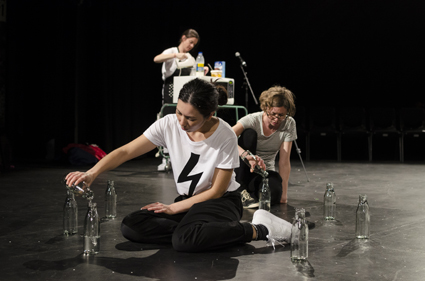Art against the clock
Teik-Kim Pok: Gail Priest, Jane McKernan, One thing follows another

Angela Goh, Lizzie Thomson, Jane McKernan, One thing follows another
photo Lucy Parakhina
Angela Goh, Lizzie Thomson, Jane McKernan, One thing follows another
It may not be a stretch to regard the performing arts today as gladiatorially pitted against the hyperreal X-Factor, The Voice and their like, contests which blur into one, hell-bent on delivering battle after battle of virtuosic talents while needlessly magnifying nondescript personalities.
One thing follows another offers a quieter alternative, taking its inspiration from the humble intermedia explorations of Fluxus, a movement which yielded works that eschewed bombastic expression, some of them sardonically catalogued by composer Gail Priest and choreographer Jane McKernan. Aided by fellow devisors Angela Goh and Lizzie Thomson, competition manifests below the surface, as the artists examine their own performance-making practices driven here by games of chance that trigger improvisation.
As the audience approach their seats in the arena, each member is given a brown paper bag containing spartan surprises: a Mintie and a handcrafted zine of reading matter which quotes seminal texts, instructions and provocations that speak to the conceptual forebears of the artists. We walk past the performers seated at a card table in the middle of the performance space as if in a miniature boxing ring, engrossed in a craft-making working bee, a mental warm up for the Big Game.
Lest we get too comfortable with the sporting metaphors, the group delivers Yvonne Rainer’s No Manifesto‚ aimed at reducing dance to its essential elements, thus muting our desire to read this endeavour as a deliberate exercise in gimmickry and interactivity. Regardless, it is impossible to ignore the three prominent video monitors above the performers, which are assigned the role of ominous timepieces, always reminding us of how much further we travel into the show’s allocated 56 minutes. Each of the 14 sections unfolds in minor increments of duration, making us aware of the finite nature of the offerings which alternate between movement, text and live sound-mixing, lulling us into an almost predictable rhythm of form and order.
But the music consciously refuses to intertwine with the action, creating Cagean disruption of notions of accompaniment and causality. Priest loops, distorts and mixes pre-recorded sounds and her own live utterances from a neat electronic sound table while the others carve up the space.
Halfway through, a muted game of handball is played alongside a sequence that could only be described as ‘mathematical notation charades‚’ involving two dancers flitting around and, with great commitment, taking instruction from simulated ticker-tape displaying mathematical symbols—fed manually as close-ups through a live video feed from a smartphone. The result is both whimsical and engrossing.
When the performers reunite around the table, a convivial game of Snap starts with little fanfare, characterised by aggressive table-slapping percussion—arousing the familiar sensation of palms flinching. Here the nostalgic audience is at one with the players.
Towards the end, the performers expand the number of proverbial plate spinnings simultaneously, including inviting volunteers to re-enact Tomas Schmit’s act of transferring water between glass bottles to the point of complete evaporation, conjuring the most overt reference to the Fluxus canon with regard to the measuring of a fluid time and ephemerality of action and matter.
Soon after, McKernan prepares and subsequently microwaves a packet mix cake, an olfactory awakening but then a backhanded treat when offered to the audience by way of a lottery. Having spent the better part of the 56 minutes inviting us to meditate and luxuriate in an expanded sense of time, it is a very apt coda to the evening. We are reminded that, beyond the theatre, where we may find ourselves in the land of the time-poor, you can speed things up in life, but nothing beats a real cake made from scratch and patiently baked in a real oven.
We are reminded that ‘time is a container,’ that we, the audience, determine those parameters within which we choose to engage with live performance. We conventionally ask of the live moment that it help suspend our sense of time as we encounter a plethora of purposefully prescribed sounds, images and emotions. In this endeavour, the opposite has been true, the show activating familiar anxieties that come from obsessively measuring time.
The assemblage of events in One thing follows another adds up to a disciplined ‘Flux-off,’ a refreshing mind-map of the movement’s spirit in celebrating the unassuming and the mundane, while inverting the brash aesthetic that has accompanied popular culture’s own obsession with the disposable.
Performance Space, SCORE: One thing follows another, co-creators Jane McKernan (choreographer), Gail Priest (composer), performer-devisors Angela Goh, Jane McKernan, Gail Priest, Lizzie Thomson, video consultant Samuel James, lighting design Clytie Smith, Carriageworks, Sydney, 20-23 Aug
RealTime issue #123 Oct-Nov 2014 pg. 23






